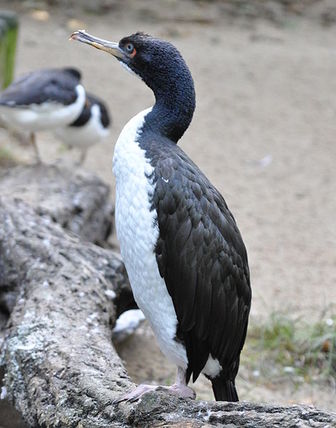Guanay Cormorant
The Guanay Cormorant is similar in coloration to the Rock Cormorant, Phalacrocorax magellanicus, but larger, measuring 78 cm from the tip of the bill to the end of the tail. Its bill is greyish with some red at the base. The face is red with a green eye-ring. It has roseate feet. The head, neck and back are black as are the outer parts of the thighs. The throat patch, breast and belly are white. In breeding plumage it has a few white feathers on the sides of the head and neck.

Original source: Quartl
Author: Quartl
The Guanay Cormorant is classified as Near Threatened (NT), is close to qualifying for or is likely to qualify for a threatened category in the near future.
The Guanay Cormorant or Guanay Shag, Leucocarbo bougainvillii, is a member of the cormorant family found in South America. It is a resident bird living on the Pacific coast of Peru and northern Chile. (The Argentinian population on the Patagonian Atlantic coast appears to be extinct.) After breeding it spreads south to southern parts of Chile and north to Ecuador, and has also been recorded as far north as Panama and Colombia – probably a result of mass dispersal due to food shortage in El Niño years. More
* Guanay Cormorant Distribution Map * The page you are on right now Guanay Cormorant Distribution Map = Please wait while map is loading... Guanay Cormorant Distribution Map large map France maps. Click on the Guanay Cormorant Distribution Map to view it full screen. File Type: png, File size: 127075 bytes (124. More
The Guanay Cormorant is the main producer of guano. Habitat loss/degradation and over-fishing have resulted in a steady decline of the population of about 30% from an estimated figure of 3 Million birds in 1984. This species is listed as NT (near threatened) by IUCN. The scientific name commemorates the French explorer Louis Antoine de Bougainville. More
Guanay Cormorant has been the dominant avian species in the Peruvian Coastal Current in terms of numbers and consumption of marine resources. The population in Peru was estimated as Web site designed by Quinn Interactive, Inc. More
The Guanay Cormorant is similar in coloration to the Rock Cormorant, Phalacrocorax... More
Guanay cormorants at Punta San Juan ( More
Over the past decades Guanay cormorants have declined ten times whereas Peruvian boobies have remained relatively stable. We suggest that the decline of the cormorants could be related to reduced social information opportunities and that social behaviour and search strategies have the potential to play an important role in the population dynamics of colonial animals. More
The Guanay Cormorant and the Peruvian Booby produced enough guano in the ... More
Family : Phalacrocoracidae
Genus : Phalacrocorax
Species : bougainvillii
Authority : (Lesson, 1837)

